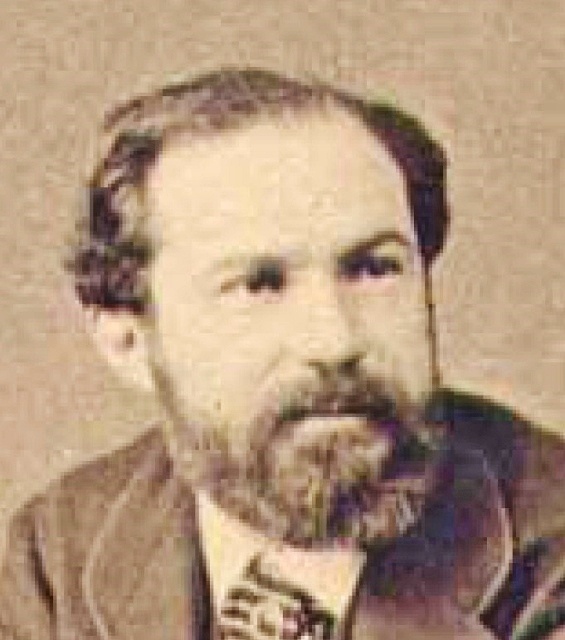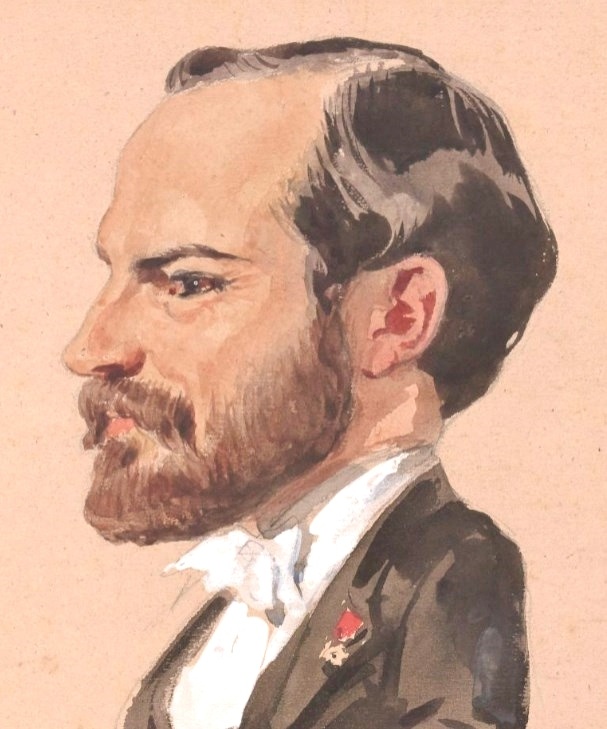Jean Baptiste (Tito) Franceschini-Pietri (1834-1915), personal secretary of Napoleon III
1st image: Soirée, 2nd & 3rd: photo's from mid 1850s and 1860 , 4th: caricature by Eugène Giraud at Nieuwerkerke's soirée, created April 7, 1865. (Alternative: Roger)
Given Jean-Baptiste Franceschini-Pietri’s interest in art and his close ties to Emperor Napoleon III, it is highly plausible that de Nieuwerkerke chose to include him in the background of Soirée au Louvre, late 1854, behind James Pradier.
Franceschini-Pietri hailed from a distinguished Bonapartist Corsican lineage. His great-uncle was the renowned patriot Pascal Paoli (1725–1807), founder of Île-Rousse in 1769. Tragically, he became an orphan at just two months old following his mother’s death.

Supported by his uncle Pierre-Marie Pietri, the prefect of Parisian police, he relocated to Paris in 1852. With assistance from his uncle and other influential Corsicans, he secured a position as a copyist for Mr. Mocquard, head of the emperor’s cabinet. This role required frequent interactions with Napoleon III, who took a liking to the bright and unassuming young Corsican.
Napoleon, known for his fondness for dogs, became especially attached to Franceschini-Pietri’s small dog, Tita. Over time, the emperor affectionately nicknamed his secretary Tito.
By 1855, Tito formally joined the emperor’s team of personal secretaries and, in 1864, was promoted to private secretary. His unwavering dedication became legendary, and his influence was immense. Beyond his relationships with fellow Corsican and congress secretary Count Vincent Benedetti38b, and Minister Eugène Rouher, Franceschini-Pietri frequently liaised with Count de Nieuwerkerke, advocating for artistic commissions to the emperor. In 1869, statesman Émile Ollivier —widower of Blandine Liszt50b — suggested to the emperor: “Isn’t [Franceschini-] Pietri cut out for the position of Minister of the Interior? I would strongly support him.” However, with the fall of Napoleon III’s empire in 1870, this proposal never materialized. Loyal to his emperor and empress, Franceschini-Pietri accompanied them into exile in England, where he remained until his passing on December 10, 1915, in the arms of the empress.
I cannot end this profile without telling one short story of the Franceschini family:
Jacques and Silvia Franceschini, a young couple from Corsica, altered the course of history when Tunisian pirates (Barbareschi) abducted them from their homeland in 1754 and sold them in the Tunis’ slave market to the Bey.
While in captivity, they had a daughter and a son, and Jacques eventually rose to a position within the Bey’s administrative office. Upon overhearing a plot to assassinate the Bey, Jacques informed his master. In gratitude, the family was granted their freedom and set sail for Corsica aboard a Tuscan trade vessel in 1763. However, Moroccan pirates intercepted the ship, and the Franceschini family was sold again, this time to serve under a brutal overseer in the imperial gardens of Marrakech.
Fluent in the local language, Jacques managed to smuggle a message to the Sultan of Morocco, arguing that his family belonged to the Bey of Tunis and therefore could not be enslaved in Morocco. In 1767, the Sultan Sidi Mohamed Abdallah (Mohamed III) granted Jacques an audience to present his case.
While accepting his plea, the sultan was captivated by the beauty and intelligence of Jacques' twelve-year-old daughter, Martha. He agreed to send the Franceschini family back to Corsica—but only on the condition that Martha remain in his harem. Despite Jacques’ desperate attempts to rescue his daughter, he was unsuccessful and died of the plague in June 1770.
Within the sultan’s harem, Martha was given the name Dawiya, meaning “the light one”. She eventually became his favorite concubine and, in 1786, was officially recognized as his legitimate wife, ascending to the role of empress.
During the reign of Napoleon I, Corsican-born like herself, she played a crucial role in strengthening diplomatic relations between the Sultan of Morocco and France, demonstrating that diplomacy ran in the Franceschini family’s veins.



